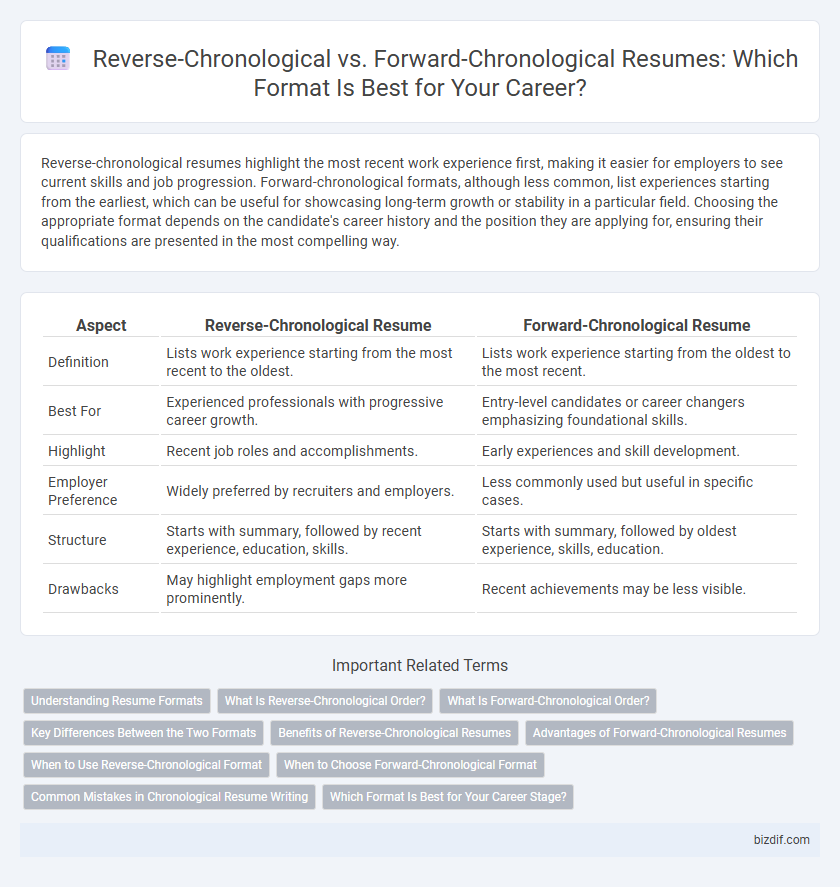Reverse-chronological resumes highlight the most recent work experience first, making it easier for employers to see current skills and job progression. Forward-chronological formats, although less common, list experiences starting from the earliest, which can be useful for showcasing long-term growth or stability in a particular field. Choosing the appropriate format depends on the candidate's career history and the position they are applying for, ensuring their qualifications are presented in the most compelling way.
Table of Comparison
| Aspect | Reverse-Chronological Resume | Forward-Chronological Resume |
|---|---|---|
| Definition | Lists work experience starting from the most recent to the oldest. | Lists work experience starting from the oldest to the most recent. |
| Best For | Experienced professionals with progressive career growth. | Entry-level candidates or career changers emphasizing foundational skills. |
| Highlight | Recent job roles and accomplishments. | Early experiences and skill development. |
| Employer Preference | Widely preferred by recruiters and employers. | Less commonly used but useful in specific cases. |
| Structure | Starts with summary, followed by recent experience, education, skills. | Starts with summary, followed by oldest experience, skills, education. |
| Drawbacks | May highlight employment gaps more prominently. | Recent achievements may be less visible. |
Understanding Resume Formats
Reverse-chronological resume format lists work experience starting with the most recent position, highlighting career progression and stability favored by recruiters. Forward-chronological resumes present experiences beginning with older roles, which can be useful for showcasing a strong foundational background or career shifts. Choosing the right format depends on career goals, work history relevance, and industry standards to effectively demonstrate skills and achievements.
What Is Reverse-Chronological Order?
Reverse-chronological order arranges resume entries starting with the most recent experience and works backward. This format highlights career progression and is preferred by recruiters for its clarity in showcasing recent job roles and achievements. Employers quickly assess a candidate's current expertise and work history using this straightforward structure.
What Is Forward-Chronological Order?
Forward-chronological order in resume writing lists work experience starting with the earliest job and progressing to the most recent. This format highlights career growth and development over time, offering a clear timeline of skills acquisition. It suits candidates with consistent job history and steady professional advancement.
Key Differences Between the Two Formats
Reverse-chronological resumes list work experience starting with the most recent job, highlighting career progression and current skills, which is ideal for professionals with continuous employment history. Forward-chronological resumes begin with the earliest experience, emphasizing long-term growth and foundational skills, often preferred for showcasing consistent development in entry-level candidates. The key difference lies in presentation order, impacting how employers perceive career trajectory and relevance of experience.
Benefits of Reverse-Chronological Resumes
Reverse-chronological resumes highlight the most recent job experience first, allowing employers to quickly assess a candidate's current skills and career progression. This format enhances clarity and readability, making it easier for hiring managers to follow the applicant's work history and achievements in a logical sequence. Prioritizing recent roles also emphasizes professional growth and relevant expertise, which can improve chances of securing interviews in competitive job markets.
Advantages of Forward-Chronological Resumes
Forward-chronological resumes emphasize career progression by listing work experience from earliest to most recent, showcasing steady growth and development. This format highlights long-term commitment and skill accumulation, making it ideal for candidates with consistent employment history. Employers appreciate its clear timeline, which simplifies assessing a candidate's career trajectory and professional maturity.
When to Use Reverse-Chronological Format
Use the reverse-chronological resume format when showcasing a solid, consistent work history with recent relevant experience. This format highlights career progression by listing jobs from most recent to oldest, ideal for professionals with steady employment in the same industry. Employers often prefer this structure for quickly assessing recent accomplishments and job stability.
When to Choose Forward-Chronological Format
The Forward-Chronological resume format is ideal for career changers and recent graduates with limited work experience, as it emphasizes skills and education over job history. This format highlights a logical progression of skills and training, making it easier for employers to see relevant qualifications despite limited professional experience. Choosing Forward-Chronological resumes benefits candidates aiming to showcase their potential and transferable skills without a traditional employment timeline.
Common Mistakes in Chronological Resume Writing
Common mistakes in reverse-chronological resume writing include listing job experiences without clearly highlighting achievements, leading to a monotone presentation that fails to capture recruiters' attention. Forward-chronological resumes often confuse employers because they start with older roles, making it harder to assess recent skills and career progression effectively. Prioritizing clear dates, action verbs, and relevant accomplishments improves readability and impact, regardless of chronological order used.
Which Format Is Best for Your Career Stage?
Reverse-chronological resumes highlight recent work experience first, making them ideal for professionals with a consistent career progression or those seeking roles in the same industry. Forward-chronological formats emphasize earlier roles and can benefit career changers or entry-level candidates by showcasing foundational skills and education. Choosing the right format depends on career stability, industry norms, and the specific job target to effectively showcase relevant qualifications.
Reverse-chronological vs Forward-chronological Infographic

 bizdif.com
bizdif.com